Hayes Farm Hike – Full PDF
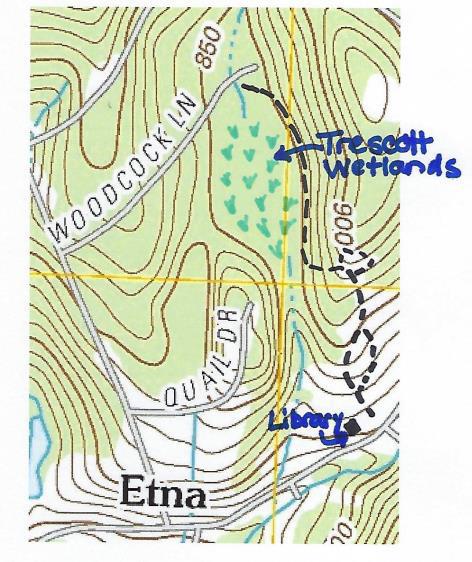 Driving Directions
Driving Directions
- This hike begins at the Etna Library at 130 Etna Road.
- From downtown Hanover, follow East Wheelock Street up to Grasse Road, where it becomes Trescott Road. Continue straight on Trescott Road to Etna Road.
- Turn L onto Etna Road and head N
- Opposite King Road, turn L into the Etna Library parking area.
What You Should Know
- Foot travel only. Dogs are welcome but must be under close control; please pick up after your pet.
- While this hike is not long, there are some short steep sections and some tricky footing.
- We suggest bringing a picnic and binoculars, and allowing extra time to enjoy this spot.
- You are exploring land acquired by the Town of Hanover in two phases – the 12.9 acre Trescott Ridge Wetlands, set aside when the “bird roads” (Woodcock, Partridge, and Quail Lanes) were laid out, and Hayes Farm Park, 9.4 acres acquired from the estate of Ethel Hayes in 2010. On the way, you’ll visit the King Bird Sanctuary, established in 2011 by the Hanover Conservancy and the Audrey McCollum Trail, built in 2017.
Hiking Directions
- Begin your hike at the sign reading, “0.5 miles to Woodcock Lane/0.2 miles to King Bird Sanctuary.” Head up the mown path toward the trailhead kiosk visible above the meadow.
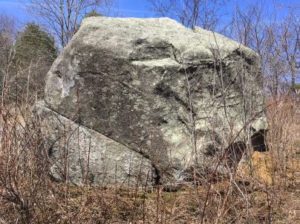 A massive boulder, looking quite out of place, looms ahead. This is a glacial erratic, plucked by the glacier from someplace northwest of here and unceremoniously dropped when the glacier receded, melting around it and leaving it behind. If you look closely, you can see that one H. L. Huntington spent quite a bit of time here on Sept. 14, 1872, carving the erratic’s first (and hopefully only) graffiti.
A massive boulder, looking quite out of place, looms ahead. This is a glacial erratic, plucked by the glacier from someplace northwest of here and unceremoniously dropped when the glacier receded, melting around it and leaving it behind. If you look closely, you can see that one H. L. Huntington spent quite a bit of time here on Sept. 14, 1872, carving the erratic’s first (and hopefully only) graffiti.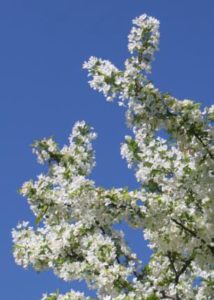
- Pass L of the boulder and up into a small orchard of crabapples (L) that promise to be lovely at some point in May. Resolve right now to return to catch the show.
- The trail is short and sometimes steep. Five minutes’ walk from your car, reach the top of a rise with the next of many fascinating features before you – a stone wall comes in at R. Close inspection reveals wide-mesh sheep fencing topped with a strand of barbed wire, clues that you are standing in what was sheep pasture (1820s-70s) and later pasture for cattle (to mid 20th century).
- Continue down into the broad sheep lane with its fine stone walls on both sides. Halfway along, there’s a gap in the wall at R – your return route.
- For a former sheep lane, this is a pretty interesting place ecologically. Here and there blue flags, set by the town’s Biodiversity Committee, indicate native plants to be tracked. Woodcock frequent the area, as do flocks of turkeys.
- Follow the lane up the next knoll. A sign directs you R to the King Bird Sanctuary. The distinctive boulder seat, your next destination, appears up at L. It’s time for a picnic, or at least to pull out the binoculars!
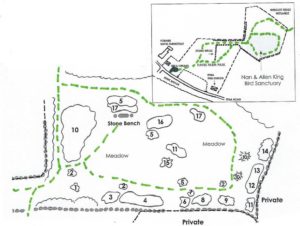 The Hanover Conservancy and Hanover Conservation Commission partnered to create this sanctuary to honor Nan and Allen King, prominent Hanover conservationists, and to benefit Etna Village. On the Upper Meadow of Hayes Farm Park, the sanctuary features a naturalized planting of hardy native trees and shrubs to benefit wildlife. It was dedicated on June 30, 2011, the Kings’ wedding anniversary. In addition to the Conservancy’s King Memorial Fund, many volunteers and donors helped make the project possible.
The Hanover Conservancy and Hanover Conservation Commission partnered to create this sanctuary to honor Nan and Allen King, prominent Hanover conservationists, and to benefit Etna Village. On the Upper Meadow of Hayes Farm Park, the sanctuary features a naturalized planting of hardy native trees and shrubs to benefit wildlife. It was dedicated on June 30, 2011, the Kings’ wedding anniversary. In addition to the Conservancy’s King Memorial Fund, many volunteers and donors helped make the project possible.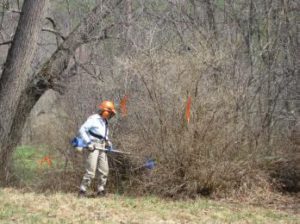
- From your seat on the boulder, imagine this knoll as open pasture. A few such meadows can still be seen across the Mink Brook valley, but most have since grown up to pine. This piece was grazed longer and allowed to grow up more recently, with unforeseen and dire effects – what came in was not only white pine, but thick tangles of invasive non-native plants, including bristly Japanese barberry, honeysuckle, and glossy buckthorn. It took brave volunteers to cut the invaders and heavy equipment to pull them out by the roots.
- Replacing them are plantings of native northern New England trees and shrubs that are more reliable and less demanding than exotic varieties, and provide better food, cover, and nesting habitats for native birds and other creatures. All of the plants displayed here are excellent alternatives for the home landscape. Look for tags identifying the plants, their value to wildlife, and ornamental qualities. You’ll want to visit the Sanctuary throughout the seasons to see the changing palette of flowers, fruits, and foliage, and to enjoy a quiet view of the birds and mammals who make this their seasonal or permanent home.
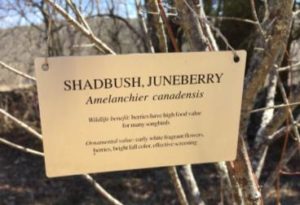 First up in spring are the delicate, fragrant white flowers of shadbush, also called serviceberry and Juneberry. Old-timers associated the blooming of this plant with the spring migration of American shad and also the time for burial services for those who died in winter when the ground was frozen. You’ll find three specimens of this small tree at the King Sanctuary. In June, brightly colored berries follow the flowers, attracting birds. In fall, it sports brilliant foliage.
First up in spring are the delicate, fragrant white flowers of shadbush, also called serviceberry and Juneberry. Old-timers associated the blooming of this plant with the spring migration of American shad and also the time for burial services for those who died in winter when the ground was frozen. You’ll find three specimens of this small tree at the King Sanctuary. In June, brightly colored berries follow the flowers, attracting birds. In fall, it sports brilliant foliage.- Take a few minutes to explore the King Sanctuary and its plantings. Follow the mown path a few yards back down to an adjoining path, and at the first of three shadbush, turn L to follow the path along a stone wall. These beautiful walls, built 200 years ago to enclose the sheep pasture, are still enjoyed by animals. At this time of year they hold the spring sun’s welcome heat through the chilly night. You might find chipmunks, garter snakes, and other creatures taking advantage of their warmth.
- After one wall opening (private property beyond) and a group of witchhazel, the wall takes a curious jog. Past a second, smaller gate, a clump of bushy young pines are all that’s left of the many that had invaded the abandoned pasture.
- Bear L and take the path over the saddle of the hill, keeping the stone seat at L. The path bends down and L past the remains of a huge brush pile left from the culling of invasives and dead trees. Now it’s a handy home for small mammals.
-

Audrey McCollum - You’ve encircled the small hill and, with another stone wall ahead, arrive at a sign for the Audrey McCollum Trail. An ardent conservationist, Audrey (R) lived nearby for many years. Gifts to the Hanover Conservancy in her memory allowed the creation of this trail linking the library to the Woodcock Lane neighborhood.
- Turn R and head downhill, following sunflower yellow blazes and entering a cool hemlock forest. At this time of year you can find such fleeting evidence of micro-climate as lingering patches of snow and ice in the hemlocks’ dense shade, when the sunny Sanctuary had long since given up such wintry garb.
- Nearing the forested Trescott Ridge Wetlands, the trail bears R and a dramatic stone wall angles down the hill at R. Step over the wall and turn R. This is good porcupine habitat – keep an eye on your dog.
- The yellow-blazed trail skirts the E edge of the wooded wetland. Note the spongy green sphagnum moss and erect beaded fertile fronds of sensitive fern. Indeed, this place IS one huge sponge – it collects and stores meltwater and rainwater, releasing it slowly into a tributary of Mink Brook. Those living as far away as Greensboro Road benefit from the flood-moderating work of this wetland.
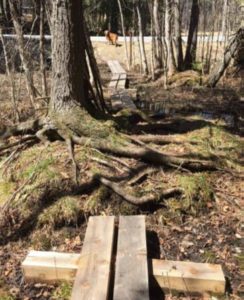
- Approaching the north end of the wetland, you encounter a bog bridge of split logs to help you over a wet spot. A few yards further, cross an impressive string of carefully fitted planks bridging more wet areas and protecting wetland plants.
- This is the work of the Upper Valley Trails Alliance with town and Conservancy volunteers who completed the Audrey McCollum Trail in 2017.
- Follow the yellow blazes to avoid nearby private land. A final pair of bridges leads to the north end of Woodcock Lane. If you want to pick up the pace and cover more distance, you could walk down the lane, turn L onto Trescott Road (beware narrow shoulder), turn L onto Etna Road, and return to your car. We think it’s more fun to retrace your steps and see what you might have missed on the way out.
- Turn around and follow the small stream feeding the wetland. It’s running well now, but slows to a trickle in summer. Signs of squirrel picnics might decorate a granite slab. Keep an eye on the blazes as you go.
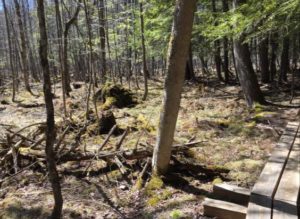 This is a very untidy environment! Mossy stumps, lumps, shrubs, standing and fallen trees create visual havoc but are part of what makes this such a valuable wetland. Note the silence of this place.
This is a very untidy environment! Mossy stumps, lumps, shrubs, standing and fallen trees create visual havoc but are part of what makes this such a valuable wetland. Note the silence of this place.- Keep the wetland immediately on your R until you reach the stone wall. Here, wildlife like mink use such places as billboards, placing scat where it can’t be missed.
- Past the wall, the trail swings up and away from the wetland and, 15 minutes from Woodcock Lane, you ascend from the woods. Stay on the path and round the corner of the stone wall (unless the King Sanctuary’s stone seat requires another visit). Head down the broad sheep lane, past an impressive quartz boulder at R.
- Turn L through the break in the wall and enter the field. Ahead, the old farm well-head gives the impression that a giant has pounded a tiny house into the ground. A cluster of flagging and fence posts indicates a population of plants being tracked and protected.
- Pass the end of the tree line and follow the path as it turns R to bring you to the library and your car. Enjoy a fine view of the historic Hayes Farm barn. This farm was owned by the Ingalls family as early as 1855; by 1892, the Stetsons farmed here. Hayes family members still live nearby.
- Before leaving, pay a quick visit to the lilac garden behind the Etna Library. This outdoor reading garden is encircled by lilac varieties brought by the Conservancy from the famed Highland Park in Rochester, New York, where Nan and Allen King met.
The Conservancy has prepared a map and guide to the King Bird Sanctuary plantings to help visitors learn more about the wildlife benefits and year-round ornamental values of these native plants. Copies are available at the Etna Library and Hanover Town Office.




